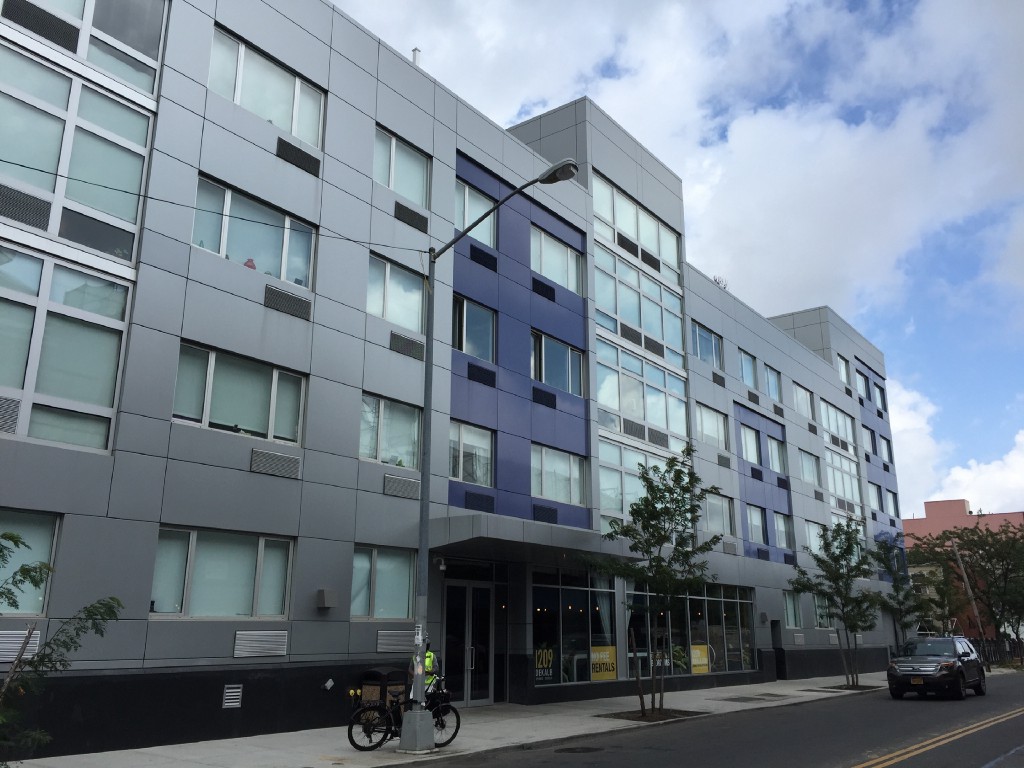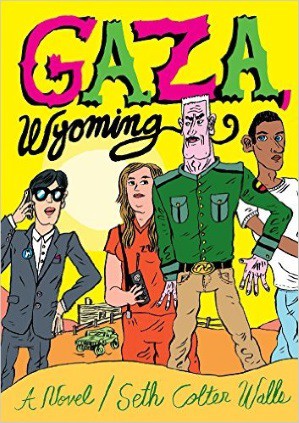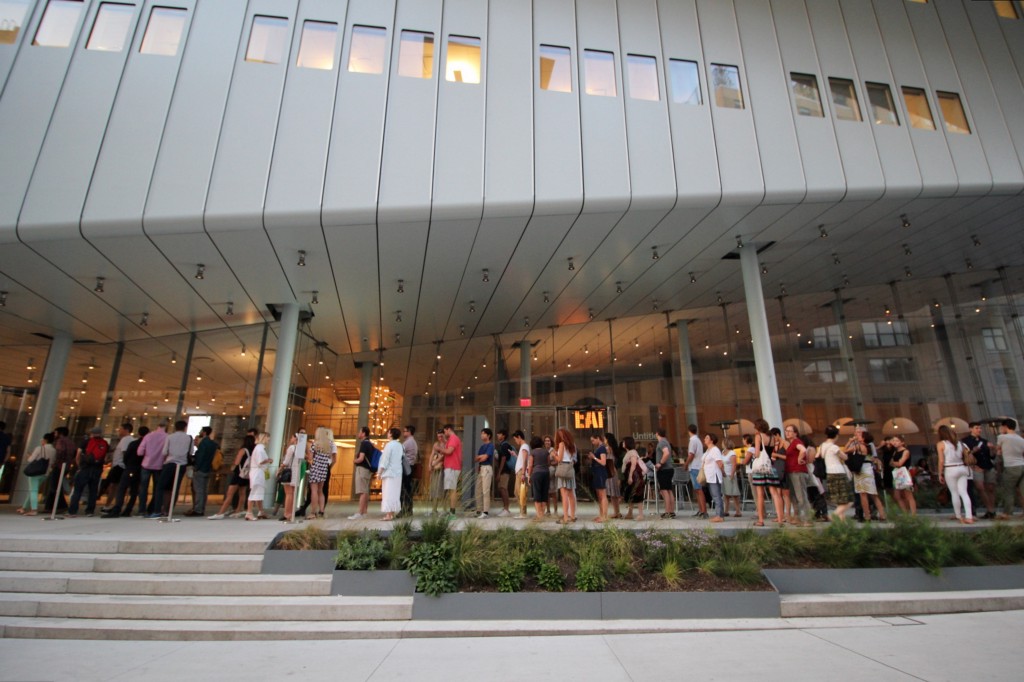Welcome to Postcolonial Bushwick
by Brendan O’Connor

1209 Dekalb Avenue #516
• $3,600 per month
• Two bedroom / two bathroom
• M train at Central Avenue; J train at Kosciuszko Street
Recently, one of Brooklyn’s most controversial luxury rental developments, at 1209 Dekalb Avenue in Bushwick, changed its name. The building, which began leasing over a year ago, in April 2014, was originally called “Colony 1209.” At the time, marketing copy from the building’s website read, “Here in bohemian Bushwick, Brooklyn, you’ll find a group of like-minded settlers, mixing the customs of their original homeland with those of one of NYC’s most historic neighborhoods to create art, community, and a new lifestyle.” It assured potential tenants, “We already surveyed the territory for you.” But, at some point this summer, the development was rebranded as, simply, 1209 Dekalb.
Last September, Samantha Maldonado wrote about the building and its name for The Awl. “To colonize a place means to overtake it, to pillage its resources, to dehumanize its people, and to attempt to erase its past,” Maldonado wrote. “Even if Colony 1209 is an exercise in self-aware irony, it’s at the expense of those who have been living in Bushwick for decades, and of those who can’t afford to live there. Irony here functions, at best, as just another exclusionary inside joke for the young and privileged.” In April, Make the Road New York, a non-profit community organization focusing on Latino and working class neighborhoods, organized a demonstration protesting tax breaks for luxury developers; the march ended outside Colony 1209.
The controversy at 1209 Dekalb Avenue, though, predates the existence of this particular building. In 2006, Eli Weinstein, a real estate investor from Lakewood, New Jersey, formed the Bushwick Enterprise Group to purchase the lot for 8.3 million dollars, while also taking out a six-million-dollar mortgage from a bank in Chicago. A couple of years later, the Department of Buildings approved a five-story, hundred-and-twenty-six-unit new construction. The original plan, according to Crain’s New York, was to build condos. However, in August 2010, Weinstein was arrested on charges that he ran a two-hundred-million dollar real estate investment Ponzi scheme in which the proposed development at 1209 Dekalb Avenue was a key component. In 2013, Weinstein pled guilty to one count of conspiracy to commit wire fraud and one count of money laundering; he was sentenced to twenty two years in prison. (Late last year, he pled guilty to another scam, in which he defrauded investors after offering them the opportunity to buy shares in Facebook prior to its initial public offering in May 2012 — shares to which he did not have access.)
In February 2012, the Chicago bank foreclosed on the property and it was auctioned off. According to Department of Finance records, in May of that year, Read Property Group paid six million dollars for the deed to the property and took out a twenty-one-million-dollar mortgage. Construction proceeded as planned, although Read Property switched the building from condos to rentals. The first Streeteasy listings posted by Aptsandlofts.com, using the name “Colony 1209,” appeared in September 2013. Leasing paused after Read Property decided to sell the building, which it did, in April 2014, to Spruce Capital Partners, a real estate investment and development firm, for fifty-eight million dollars. Leasing began again immediately after the acquisition by Spruce.

1209 Dekalb Avenue #119
• $2,634 per month
• One bedroom / one bathroom
• M train at Central Avenue; J train at Kosciuszko Street
“The original owners had it with that name. We decided to change it,” Jacob Henderson, one of the Aptsandlofts.com brokers who works with the building, told me over the phone. Henderson declined to elaborate on how the name-change decision was made or to answer other questions about how the building was marketed. Henderson was happy to talk about leasing, however. “We rented the building out once entirely. We have a few units — non-renewals — that we’re renting again this year,” Henderson said. “The prices have gone up a very small amount… There’s always an increase when units go back on the market.” Still, he continued, “For luxury new development, the price is pretty unbeatable — they rent fairly quickly.” (Through a spokesperson, Aptsandlofts.com also declined to answer questions about the name change.)
Robert Schwartz, a founding partner of Spruce Capital Partners, the building’s current owner, told the New York Times in September that the firm might convert the building to condos: “Judging from the response we’ve received from people wanting to live in the neighborhood, and seeking out luxury finishes and amenities, I don’t see why not.” Spruce Capital, which also declined to comment for this story, apparently hasn’t gotten the memo about the name change: The building is still listed as Colony 1209 in their portfolio.
According to the Association for Neighborhood Housing and Development, 1209 Dekalb Avenue received a fifteen-year tax abatement under the 421-a program, beginning July 1, 2012. “Over the life of the exemption, the building will get about 8.2 million dollars in tax exemptions, while paying less than 2 million dollars,” Moses Gates, ANHD’s director of planning & community development, wrote to me via email. Some such exemptions come with a stipulation requiring the inclusion of affordable housing in developments receiving the abatement; Colony 1209’s did not.
“The new name is less offensive, but if they just changed the name without changing anything else, there’s no real difference,” Bushwick resident and Make the Road member María Najera wrote to me in an email, sent via a spokesperson. “The building will keep being unaffordable to local residents and being part of the gentrification that dislocates us.” In July, according to market analysis by residential brokerage MNS, the average rent for a one-bedroom apartment in Bushwick was just under $2,100 per month. Three years ago, in July 2012, it was $1,756 per month.

1209 Dekalb Avenue #207
• $2,204 per month
• One bedroom / one bathroom
• M train at Central Avenue; J train at Kosciuszko Street
Sarah Quinter, an artist and activist born and raised in New York City, has lived in Bushwick for the past seven years. After biking past Colony 1209 while it was still being built and seeing the language used to market its apartments, she and others founded Reclaim Bushwick, an informal anti-gentrification and community organizing group that hosts bi-lingual meetings in area churches. “We never just wanted the name change,” Quinter told me over the phone this week. “When you are gentrifying this neighborhood, you are taking away other people’s ability to live here, and to feel like they belong here. So, you should give something back to the community.” She continued, “The name change is a kind of flip way for them to deflect some of the attention, so they don’t have to give up real concessions.”
“If Colony had to give up the amount that it saved from 421-a, you could buy some buildings with that, and they could be community land trusts, and those spaces could actually be anti-displacement community centers where people could come and get support,” Quinter said. “There’s an equation to this: They are taking something; if we had it, we could do something. To have a vision like that shows the relationship between what happens when they have power and resources versus if the community has it — like, what we would be doing with it.”
The arrogance of the way that Colony 1209 — a deeply ugly building — presented itself to the world until recently was, while offensive, refreshing in its honesty. (Maybe.) None of the ambivalent, anxious rhetoric of lower-income creatives who initiated an earlier wave of displacement here — just the blithe, bare-faced language of settlement and colonization. Truth in advertising! They can change the name, but the building isn’t going anywhere: After all, everyone has to live somewhere.
Have you noticed a real estate listing that you would like to have investigated? Send cool tips, fun listings, and hot gossip to brendan@theawl.com.
'Gaza, Wyoming'

I would say the number one question I get from people I talk to these days is, “What do you think the world would be like if President Obama lost the 2012 election and, after the Israel-Hamas conflict of 2014, President Romney pushed through a Middle East peace plan that required the U.S. to absorb the Palestinian refugee population, outside the West Bank, which resulted in camps being built in Wyoming?” To which my answer is, “Fuck if I know, I can barely imagine what the world would be like if I were able to brush my teeth in the morning without bursting into tears.” BUT now I don’t have to share that terrible revelation of just how sorry my existence is. Now I can direct those people to a novel written by Awl pal Seth Colter Walls which explores exactly that scenario! Yes, indeed, Gaza, Wyoming, available as an e-book or a book book, is here for all of you who a) have wondered about such a thing or b) are looking to read a book (e- or otherwise) Keith Gessen calls a “beguiling debut novel… as funny as it is terrifying.” There’s an except here! Go read and buy, and, please, stop asking me that question.
Good News For Recappers, Test-Takers And Pill-Popping List-Makers
“Modafinil is the world’s first safe ‘smart drug’, researchers at Harvard and Oxford universities have said, after performing a comprehensive review of the drug. They concluded that the drug, which is prescribed for narcolepsy but is increasingly taken without prescription by healthy people, can improve decision- making, problem-solving and possibly even make people think more creatively…. A new review of 24 of the most recent modafinil studies suggests that the drug has many positive effects in healthy people, including enhancing attention, improving learning and memory and increasing something called ‘fluid intelligence’ — essentially our capacity to solve problems and think creatively. One study also showed that modafinil made tasks seem more pleasurable.”
How To Get Americans To Pay Attention To Climate Change
It is clear at this point that the repeated warnings of scientists and other experts are not enough to break through the clutter and often intentional disbelief many people have regarding climate change, so I cannot think of any other way to force Americans to acknowledge its undeniable existence and catastrophic ramifications than by accompanying every report about it from now on with Nelly’s inescapable 2002 summer classic “Hot In Herre.” Eventually people will have to take note and will want to do something about the problem just to make it stop. You have a better idea? Yeah, that’s what I thought. Anyway, “the average global temperature for July 2015 was the highest for any month since record keeping began in 1880, the National Oceanic and Atmospheric Administration said. The first seven months of the year also had all-time global record highs.” Wherre is it getting hot? In herre. It’s getting hot in herre.
A Poem by Rebecca Wolff
by Mark Bibbins, Editor
Man Tits
Look at that pair,
on the one over there.
He’s young, skinny, low
muscle tone, poor, white, under-
educated . . . gazing
down
on a
path
in the little patch
of yard in front of his
unfavorably situated
rental where he stands, hands
on hips, mutable, conceivable
speculation on the next weekend
chore.
But his tits are the good
kind: fat, conical, pale against
the brown of his wife-beater tan,
nipples slightly shiny,
aureolated. Bouncy, native tits
like the ones you came to see.
Rebecca Wolff’s fourth collection of poems is One Morning — . from Wave Books. She is the founding editor of Fence and Fence books.
You will find more poems here. You may contact the editor at poems@theawl.com.
Karen O, "Singalong"
I have an idea. How about today we try a thing where we all kid ourselves that it’s going to be okay for as long as we can? Then, when we reach the point where we can’t pretend anymore, we switch things up and, instead of being upset about it, remember that nothing matters, that however much pain and sorrow we feel all the time even just looking around at other people, these are only extremely temporary occurrences and soon enough we won’t feel anything at all forever, and won’t that be great? If you think about it that way there are plenty of things to be optimistic about, right? How long can you go pretending it will all be okay? Let’s see! Good luck, I hope you can ride it all the way into the evening. Maybe this song will help. Enjoy.
New York City, August 18, 2015

★★ The phone’s flash-flood alert, blaring in the early morning dark, called attention to a storm that might otherwise have passed unnoticed. By dawn the gray clouds were dissolving through indefinite stages into gray haze. The higher sky went gradually blue, the lower sky pinkish-brown. People were walking slowly in the heat. Sun shone into the subway track beds and the foot of the elevator shaft. At 18th Street station there was a substantial puddle just past the turnstiles, the flood warning come true. By late day the light was clear, even though the breeze blowing up from the direction of the harbor was palpably sodden. Smoky orange clouds stacked under white ones. Two youngish men lugged an air conditioner in its box onto the N train and stood near one side of the door, flanked on the other side by a young man in a seersucker suit.
New York City Museums, Ranked
A listicle without commentary
by Leah Finnegan

24. Morbid Anatomy Museum
23. 9/11 Memorial Museum
22. Brooklyn Museum
21. MoMa Ps 1
20. MoMA
19. Neue Galerie
18. International Center of Photography
17. The Morgan Library & Museum
16. Tenement Museum
15. Whitney Museum of American Art (New)
14. Aperture Foundation
13. Solomon R. Guggenheim Museum
12. American Museum of Natural History
11. Scandinavia House
10. Madame Tussauds
9. The Studio Museum in Harlem
8. National Museum of the American Indian — New York
7. Museum of Jewish Heritage
6. The Cloisters
5. Whitney Museum of American Art (Old)
4. Queens Museum
3. New York Transit Museum
2. The Metropolitan Museum of Art
1. The Frick Collection
